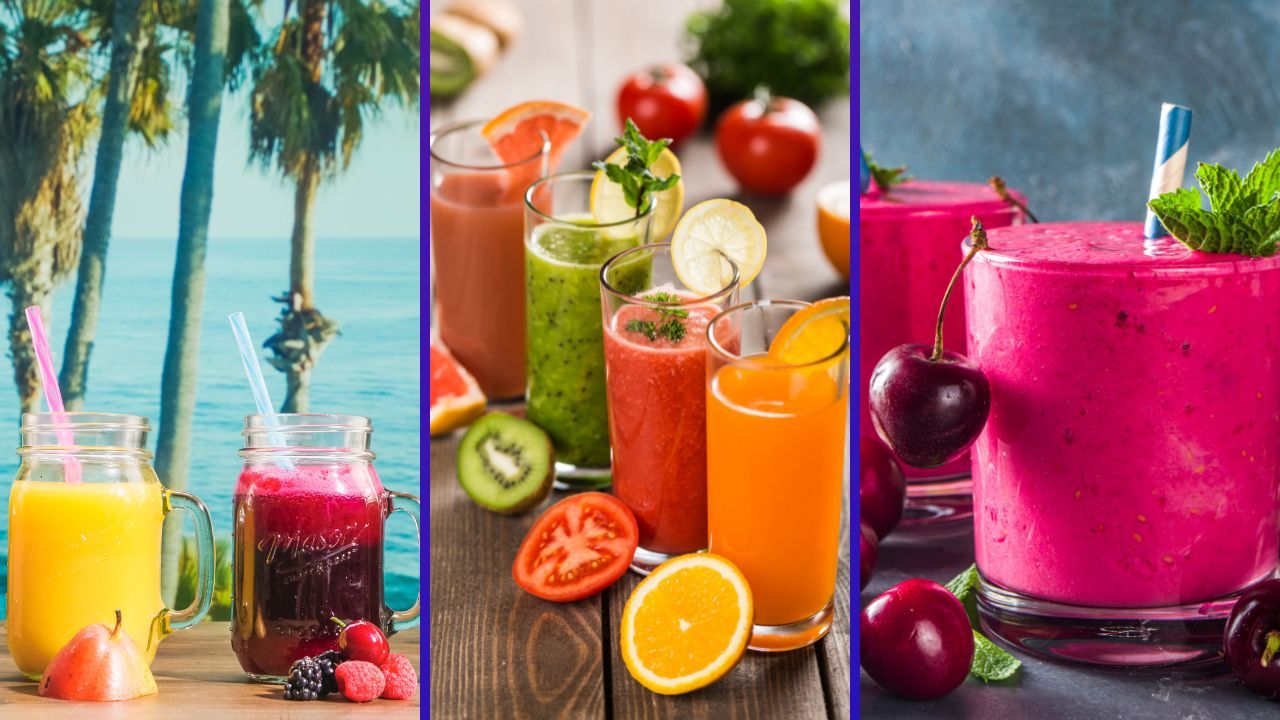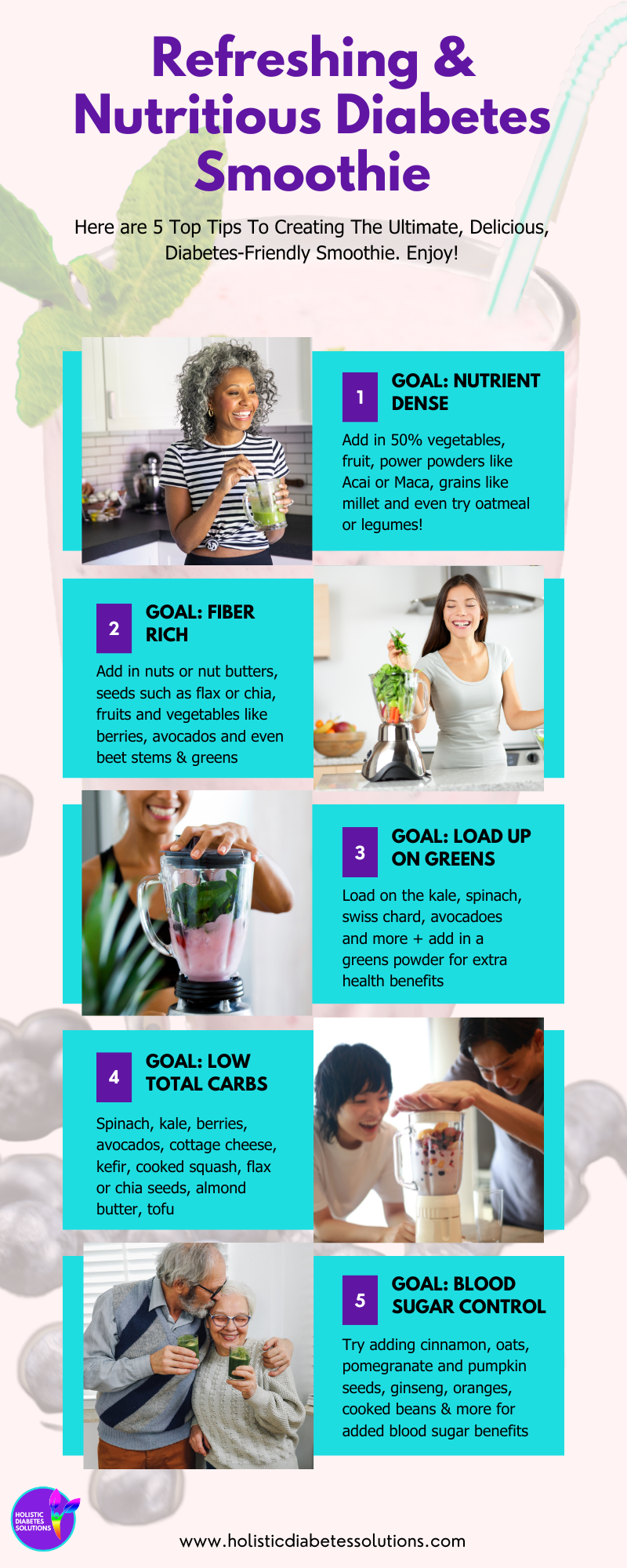
Anatomy Of The Ultimate Diabetes Smoothie
If you’re looking for a diabetes smoothie recipe loaded with health benefits, flavour and blood sugar optimizing ingredients, then I wrote this blog article especially for you.
The great thing about smoothies is that there are limitless options for nutrition and power boosts you can add in. It doesn’t take many fundamental ingredients to create your unique smoothie masterpiece that will fuel up your energy, help lower and balance your blood sugar levels, satisfy your sweet tooth and hunger and even help you sleep better! Smoothies can also be made quickly, transport well, and if loaded with the right ingredients, can even replace a meal.
Smoothies are also a fantastic way to get fiber and essential vitamins and minerals into your days. So they are special blessings on days you might be on the run or are not very hungry.
Below is an infographic with a summary of some of the diabetes smoothie tips we'll be covering throughout this article:

Table of Contents:
- Are Smoothies Diabetes Friendly?
- What Smoothies Can People With Diabetes Drink?
- Avoiding Carb Overload When Building Your Smoothie
- Breaking Down The Layers You’ll Want In Your Ultimate Diabetes-Friendly Smoothie
- Creating Your Perfectly Balanced Masterpiece
- How to Choose A Diabetes-Friendly Protein Powder
- Is A Fruit Bowl With Plain Yogurt Or Smoothie Better?
- WOW! The Best Dr. Cheryl’s Smoothie Recipe
Are Smoothies Diabetes Friendly?
YES! Here’s The Anatomy Of A Complete Diabetes-Friendly Smoothie:
First, if using a smoothie to replace a meal, aim for what you would in a balanced diabetes-friendly plate: mostly non-starchy/ vegetables (i.e. kale, spinach, chard, wheatgrass), protein, some carbs (best choice for smoothies will be fruit, yogurt, milk substitutes like soy milk, and even pumpkin) and add in some healthy fats.
In general, your diabetes-friendly smoothie should be:
- Nutrition rich
- Complete with healthy fats
- Calculated to fill your personal ideal amount of non-starchy carbs
- Filled with fiber
- Chock-full of greens, other vegetables and fruits
- Taste-bud satisfying
- Sprinkled in with other power foods to help blood sugar management
So as you can see, if you check the boxes above, there may actually be a thing as the “complete” diabetes smoothie.
What Smoothies Can People With Diabetes Drink?
An ideal diabetes-friendly smoothie contains fiber and the other suggestions from our diabetes-friendly “complete” smoothie list above, and are loaded with nutrition and filled with ingredients that support balanced blood sugars.
It’s unfortunately very easy to calorie/sugar or carb overload when creating a smoothie. Let’s face it, who doesn’t enjoy loads of rich cocoa, ripe bananas, honey and pineapples in a smoothie? However, the best way to avoid blood sugar spikes and adding extra pounds to your waistline is to make your own smoothies at home. The more control you have in choosing your ingredients, the better you can create a balanced smoothie for your blood sugars. Thus avoid pre-packaged smoothies or smoothie convenience bar stops where many smoothie options are loaded with sugar and carbs.
Avoiding Carb Overload When Building Your Smoothie
When creating your smoothie, it’s very important to be aware of the carb count of the ingredients you are adding. Your best resource here will be to use the glycemic index and a kitchen scale, until you get a good sense of carb counts per your favourite ingredients.
Low Carb Ingredients:
- Fruit such as berries, pears, avocados, oranges, apples
- Seeds such as flax, hemp or chia
- Your protein powder (most have less than 10g of carbs per serving)
- Vegetables such as spinach, cucumber, kale or even cooked squash
- Grains such as cooked oatmeal or quinoa
- Add ons such as low fat cottage cheese or plain Greek yogurt
High Carb Ingredients:
- Vegetables such as turnips or sweet potatoes (be sure to cook high carb vegetables before adding to your smoothies)
- Fruits such as pineapple, papaya and mango
- Legumes such as cooked lentils or beans
You can still greatly benefit from the fiber and nutrition in high carb options though. Just beware of carb overloading and ALWAYS measure your blood sugar when testing out new smoothie recipes.
Breaking Down The Layers You’ll Want In Your Ultimate Diabetes-Friendly Smoothie:
Protein:
- Protein powder
- Nuts
- Seeds
- Cream cheese or cream
- Cottage cheese or plain Greek yogurt
Super Foods & Power Add Ons:
- Flax, hemp or chia seeds
- Power powders such as moringa, maca, acai etc.
- Pumpkin (canned with no added sugar)
- Greens powder
Liquid:
- Almond milk (unsweetened)
- Hemp milk (unsweetened)
- Soy milk (unsweetened)
- Kefir
- Water
Fiber:
- Fruits
- Nuts or nut butters
- Seeds i.e. pumpkin seeds, chia seeds, hemp seeds, flax seeds
- Vegetables
Greens:
- Kale
- Spinach
- Beet roots/greens (beet roots and leaves are very nutritious and have a very low glycemic index compared to the actual beets)
- Swiss chard
- Greens powder
Fruit:
- Bananas (⅓ medium banana)
- Berries
- Apples
- Strawberries
- Lemons, limes
- Peaches & more!
Healthy Fats:
- Almond butter
- Avocado
- Walnuts
- Chia seeds
- Hemp seeds
- Flax seeds
- MCT oil
- Coconut oil
Flavour:
- Unsweetened cocoa powder
- Coffee
- Nutmeg
- Vanilla or almond extract
- Cinnamon
Detox:
- Lemon
- Lime
- Mint leaves
- Ginger
Dr. Cheryl Recommended Blood Sugar Balancing Add-Ons:
- Cinnamon
- Greens powders
- Oats
- Ginseng
- Pomegranate seeds
- Maca Powder
- Flax and chia seeds
- Kefir
Creating Your Perfectly Balanced Masterpiece:
Fortunately, creating a smoothie is perfectly forgiving and customizable, but please be aware of portion sizes. Just as it takes some practice to create an ideal diabetes-friendly plate, so too will it take some practice to craft a balanced smoothie.
Step 1:
Fill ½ your blender with your non-starchy vegetables such as kale, spinach, celery, cucumber, etc. The trick is to find the vegetable options that mix best with your other added ingredients. This can take some time to get to your flavour satisfaction, but well worth the time investment.
Step 2:
Top the vegetables with ¾ cup of fruit. Berries are likely the most popular option, but I also love the mixed flavour of peaches with a few cherries
Step 3:
Add in your healthy fats such as your almond butter, MCT oil and/or avocado slices
Step 4:
Add in your power boosts such as maca or moringa powder
Step 5:
Add in some of Dr. Cheryl’s blood sugar balancing add ons such as cinnamon, freshly sliced ginger, curcumin and pomegranate seeds
Step 6:
Add in flavour options such as vanilla extract or even try some freshly cut herbs
Step 7:
Add in your liquid such as almond or hemp milk, or water
Step 8:
Press the power button on your blender for a few seconds and enjoy!
How to Choose A Diabetes-Friendly Protein Powder
The great news is that most protein powders contain under 10g of carbs per serving.
It’s also important to look at the amount of protein you need per day, to determine how much protein to add to your smoothie. According to Harvard Education, you can determine your required protein intake by multiplying your weight in pounds by 0.36. (1)
For most protein powders, you’ll get 10-30g of protein per scoop. You’ll thus need to adjust the amount based on your daily protein goal and the amount of protein you’ve already had that day – in addition to considering the other protein sources you are adding into your smoothie such as almond butter, other nuts, lentils, yogurt, substitute milk sources, etc. For the most part, if you aren’t a high performing athlete or doing vigorous workouts more than 3 times per week, you’ll *likely require less protein, so that should be taken into consideration when selecting your protein powder (*some people require more protein based on medical conditions or stress, so it’s important to check in with your medical expert). Also, it’s important to note that protein powder should NOT be used as the main source of protein in your diet or be used daily to replace your other daily meals which should contain protein.
Many brands of protein powders are also loaded with added sugars. You’ll need to check protein powder labels for overall total sugars. Fortunately, more brands are using stevia as a healthy sugar substitute in protein powders, and from the ones I’ve tried, they are delicious and definitely sweet tooth satisfying.
An important tip is to consider the manufacturer or source of the protein powder, as many protein powders are filled with toxins and heavy metals.
Protein Powder Power Tip: Aim for a protein powder that also mixes in greens or be sure to add a greens powder to your smoothie. Greens powders are loaded with essential vitamins and minerals such as calcium, potassium and selenium, and overall greens powders can promote a healthy gut while helping to reduce inflammation. Greens powders also help with healthy blood sugar levels. Note: greens powders should always be used to SUPPLEMENT and not replace your healthy diet.
Is A Fruit Bowl With Plain Yogurt Or A Smoothie Better?
You may be wondering if it’s best to make a yogurt bowl with fresh fruit or a smoothie. Both are excellent options! Here are some quick considerations for you:
Fiber is very important when you have diabetes and eating whole fruits and vegetables is an excellent way to get fiber. Luckily, when blending a smoothie, all of that fiber remains in the smoothie. The only time you may lose fiber is if using a juice extractor and discarding the fiber filled pulp. Thus either a smoothie or yogurt bowl are both excellent choices if not using a juice extractor.
When creating your smoothie, it’s easy to add in more of the good stuff – especially if adding in something you particularly don’t like (but that’s good for you) and masking its flavour with everything else you add in. For example, I don’t like the taste of kale, but can’t even taste it when blending it into my smoothie! It’s much harder to mask these flavours in a yogurt bowl and let’s face it, a yogurt bowl filled with kale is not exactly appetizing;)
As a plus for your bowls and smoothies, you can top both off with all kinds of healthy and tasteful ingredients. You can find hundreds of variations of smoothies, smoothie bowls, fruit bowls and power bowls all over social media – all stocked full of fantastic nutritious ideas. These are all great ways to mix flavours and have some fun while fuelling your body!
With fresh fruit bowls, chances are you’ll use fresh produce vs. frozen – typically used in smoothies. Fortunately, you are not losing any nutrition by using frozen fruit or vegetables. As a matter of fact, fruits and vegetables are picked when they are at their maximum ripeness, and frozen immediately to prevent the loss of nutrients. With frozen fruits and vegetables you can also get varieties you might not be able to access fresh at your local supermarket. Just check that there is no added sugar on the labels. So whether fresh or frozen, or in a fruit bowl or smoothie, is entirely up to your preference.
WOW! The Best Dr. Cheryl’s Smoothie Recipe
Here is one of my personal smoothie recipes which works like magic to keep my energy up and blood sugar levels under control. Please test it out and let me know what you think.
Ingredients:
- ½ cup of spinach mixed with kale
- ⅓ medium banana (not overly ripe)
- ½ cup mixed berries
- 3-4 peach slices
- 2 tablespoons of mixed seeds (hemp, chia and flax)
- ¾ scoop protein powder
- 1 scoop of greens powder
- 1 tablespoon almond butter
- 1 tablespoon canned pumpkin puree
- ½ - ¾ cup plain Greek yogurt or Kefir
- Dashes of turmeric and cinnamon
- Fill with unsweetened almond milk or water (or use a 1/2 and 1/2 mixture)
Procedure:
- Mix all ingredients in a blender
- Enjoy!
It’s time to get into the driver’s seat of your diabetes with the power of delicious smoothies that won’t have you feeling deprived and designed to fuel your body with nutrition.
Would you like even more diabetes-friendly mouth-watering recipes? If so, please check back for our FREE 1-Day Diabetes Meal Plan! Coming Soon!
ABOUT THE AUTHOR

Dr. Ac., C.H., RDH
Dr. Holistic Studies, Dr. Acupuncture
Diabetes Wellness Strategist & Coach
Creator & CEO of Holistic Diabetes Solutions
8 X International Best-Selling Author
As a woman living with diabetes for over 30 years, Dr. Cheryl understands the journey firsthand. When she was diagnosed, she received the same outdated advice her grandmother was given for over four decades, who relied primarily on medication, suffered from deteriorating health and eventually lost her life to diabetes. Fueled by this experience, Dr. Cheryl was compelled to seek a better way. Through countless research studies and trials, she developed the winning holistic approach: the Diabetes Success System which merges traditional wisdom with today’s best holistic self-care practices. It has revolutionized diabetes management by providing a trusted way to maintain consistent and predictable healthy blood sugar levels. Join the thousands of people worldwide who have been empowered by Dr. Cheryl's approach and start living your healthiest life.
Resources:
(1) Harvard Health Publishing (2022). HOW MUCH PROTEIN DO YOU NEED EVERY DAY? Retrieved from: https://www.health.harvard.edu/blog/how-much-protein-do-you-need-every-day-201506188096#:~:text=To%20determine%20your%20daily%20protein,grams%20of%20protein%20a%20day.
____________________________________
PROFESSIONAL DISCLAIMER
The material and content contained in this platform is for overall general diabetes health and education information only. It is not intended to constitute medical advice or to be a substitution for professional medical recommendations, diagnosis or treatment. All specific medical questions or changes you make to your medication and/or lifestyle should be discussed and addressed with your primary healthcare provider. Having the right mindset, doing the right movements at the right times of day, and eating foods that help keep blood sugar, insulin, and inflammation manageable can dramatically reduce your risk of the all-too-common complications of Diabetes, increase your energy levels and have you feeling your best every day.






